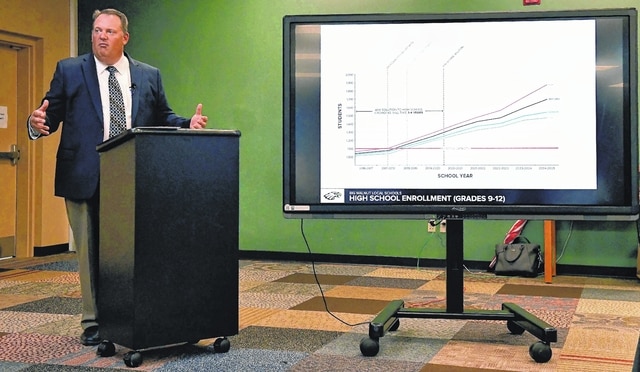
Waiting to build a new high school will be more costly — even for one year — Big Walnut school board members were told last week.
Facilities planning committee member Bob Keuderle and Zack Price of Triad Architects attended the April 21 school board meeting to present information they also present during their committee’s community forums.
Asked about timing, Price said that, because of the three- to four-year build time, the earliest a new high school could open would be for the 2020-21 school year.
Asked about community members questioning putting a $135 million bond issue on the November ballot, or waiting six months to one year to determine if enrollment projections hold true and student populations continue to increase, Price said that would increase project costs.
“If you open a new high school one year later, the cost would be an additional $4 million at 3 percent inflation,” Price said.
Superintendent Angie Pollock said that in addition to the financial impact, the risk of inflation and interest rates increasing, there would be an educational impact caused by overcrowding.
Keuderle explained that the district’s 2015 enrollment study, with low and high-end projections for student population growth over the next decade, resulted in many surprises. The most surprising discovery of all, Keuderle said, is that Big Walnut — even if low-end projections hold true — would run out of classroom space in the not-too-distant future.
“By 2019 the last of our school buildings to go over capacity goes over, and that’s using the enrollment study’s low-end projections,” Keuderle said. “At the high end of the projections, the high school crosses over in the 2017-18 school year, and it takes three to four years to get a high school open.”
Keuderle said members of the facilities committee considered three options for addressing residential growth:
• Adapt to growth by using mobile (modular) classrooms.
• Renovate and expand the district’s existing school buildings.
• Build a new high school, with a capacity of 1,850 students, and one new elementary school.
“If we choose option 1, we would need 67 mobile classrooms in 10 years,” Keuderle said. “That would cost $4 million out of the general fund and, because modulars are not as efficient, they would cost two times as much to heat and cool, and there would be increased security costs.”
Keuderle said option 2 would be highly disruptive and more costly than option 3.
“Option 3 is our committee’s recommendation to the board,” Keuderle said. “Build a new high school on a new site that’s centrally located where traffic would work, move the middle school students to the high school, move the intermediate students to the middle school, and turn the intermediate school into an elementary school and consolidate in-town preschool at that facility.”
Price said option 2 would require two new elementary buildings and cost $148 million; option 3 would cost $135 million.
“It would cost $17 million each for two new elementary buildings, plus $80 million for high school renovations,” Price said. “A new high school would cost $87 million, but you would only need one new elementary building. Building new versus renovating would save the school district $14 million.”
“Big Walnut Elementary is quickly filling up, and Rosecrans Elementary is already packed,” Pollock said. “You can’t get as creative at the elementary level as you can at the high school. At the high school it’s more about common spaces – lunchrooms, the auditorium, long lines at restrooms between classes, and operational problems to keep things safe.”
Board President Mindy Meyer asked Pollock whether the district would still need modular classrooms until a new high school and elementary building open, if enrollment projections reach the high end.
“There’s still a chance we’ll need modulars,” Pollock said. “There’s some swing space at the intermediate school. Our hope is not to put out modulars but, at the high end, it’s more likely that might happen.”
Keuderle said members of the facilities committee believe waiting would be a mistake.
“I don’t think anyone is arguing for zero growth,” Keuderle said. “Even if student population growth is at the low end, we needed to start in the past.”
Keuderle said a $135 million bond issue on November’s ballot would cost district homeowners 8 to 9 mills.
“A lot of people like Big Walnut because it’s affordable,” Keuderle said. “We have the second lowest millage in Delaware County. The lowest is Buckeye Valley, the second lowest is Big Walnut. Adding 8 to 9 mills would still keep us the second lowest in the county, and more rooftops will bring costs down as people move in. The community’s commercial development will bring that down even more.”


